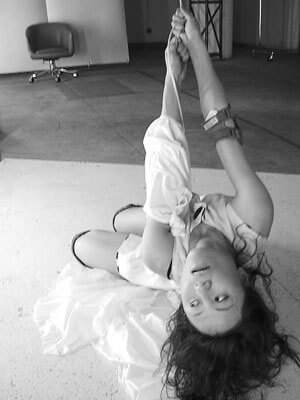Flood of video images informs, koosil-ja’s commentary on human mortality
In koosil-ja’s “deadmandancingEXCESS,” a tragic figure dies—35 times. A few “real” dances in between clear the palette. In this compressed performance, koosil-ja voraciously wedges in as many deaths as possible, only diverting her energy to make passionate love to an immobile partner, to climb a stair (only to descend again into agony) or to enact the life of a dancer who gives up her art for matrimony, finally slitting her wrists.
Koosil-ja presents the high drama of death in its many forms—suicide, samurai feat, condemnation by hanging and gunfire, amid a backdrop of 34 TV screens that all confront us with the same image. The set is about as cozy as a Circuit City store. The sound blares unmercifully at times; florescent house lights glare throughout the performance making it difficult to see from certain points; we repeatedly stiffen with the gut-wrenching ‘bang’ of gunshot. At one point in what is virtually an evening-length solo, koosil-ja wheels a hospital pole with only a tube of light hanging from it. A cord trails behind and the plug skips on the floor.
The crazy quilt of video clips is a game for multi-taskers who might recognize filmic sources the likes of “Platoon” and noir classics; but koosil-ja’s feigned deaths take center stage. When the dramatic climax of life’s expiration is repeated in an hour-long loop, it is exhilarating, even if exhausting.
When koosil-ja needs a break from her marathon of death, she sits in a chair at the edge of her stage, even then lip-synching or mimicking the expressions of the characters on the screens. Most of the action takes place on the stage. When Geoff Matter fills in as her comatose lover, she ends the one-way affair with “stop”—the only word spoken by her in the performance. He goes back to his post at a laptop orchestrating the symphony of video vignettes that seem the lifeblood.
Koosil-ja hangs from a trapeze. She enlivens a lantern-like form and a group of weights by manipulating the system of cables and pulleys from which they hang. She leans on the cables at a vertiginous angle, as if displaying her own dead weight. She is ghoulish in a basted dress, half black and with a long red chiffon trailing like fake blood. Several times she takes a few steps with Japanese wooden heeled shoes and then returns to her dying, which begins to take on ritualistic proportions—not so different than other archetypical dances of death. But “deadmandancingEXCESS” is stripped of prettiness, platitude and perfection.
Koosil-ja parodies our fascination with death by mimicking the noir cinematic fantasies that entertain us; her performance amidst the nostalgic video images adds humor that belies the subject. And this is well and good in a dance. But then matters degenerate to TV scenes of police brutality and Abu Ghraib as koosil-ja dances with a bright pink bag over her head—the red flag recalls our horror. She goes beyond movie tragedy, evoking the reality of life on the streets of Fallujah, Palestine, Israel and Anytown.
Only once does koosil-ja seek our approval. She asks ‘Do you like this music?’ (through Tom Hanks’ voice). It is during a penultimate Maria Callas melody from the film “Philadelphia.” The piece “fills us with hope,” we hear, and then: “I am life.” She pirouettes bittersweetly.
Geoff Matter and Tara Webb spent a year collecting the images that obliquely accompany the dance. The spectator struggles to process the images as they are compressed into the piece as a backdrop. koosil-ja moves with the stage presence of a Japanese theater actor. The powerful performance is a tour de force symphony, though one of essential discomfort.
Koosil-ja’s “deadmandancingEXCESS” was presented by Danspace Project at The Performing Garage October 14 through 23.


































